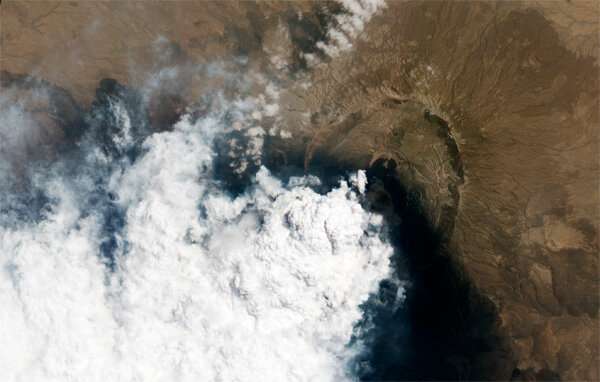Scientists reveal influence of Asian summer monsoon on volcanic aerosol transport
Aerosols transported to the upper troposphere/lower stratosphere (UTLS) region potentially reduce average global surface temperatures and alter atmospheric circulation. Although large volcanic eruptions are rare in recent decades, small and medium volcanic eruptions have continuously increased stratospheric aerosol levels.
The Asian summer monsoon (ASM) is a significant system in the Northern Hemisphere. Understanding its influence on the transport and exchange of volcanic aerosols is significant for exploring the distribution of volcanic aerosols and their potential climate effects.
Researchers led by Dr. Wu Xue from the Institute of Atmospheric Physics (IAP) of the Chinese Academy of Sciences and their collaborators from the Jülich Supercomputing Centre in Germany retrieved realistic, altitude-resolved SO2 emissions of a middle-latitude volcanic eruption and a tropical volcanic eruption. They initialized the simulations of the long-range transport and dispersion of the sulfate aerosol plumes with the retrievals in order to study the influence of the ASM system on the long-range aerosol transport.
The study was published in npj Climate and Atmospheric Science on Feb. 21.
Comparing the transport of the aerosols produced by the Sarychev eruption in 2009 and the Nabro eruption in 2011 under the influence of the ASM, they found that the ASM could enhance the quasi-horizontal meridional transport between the middle latitudes and the tropics.
Furthermore, the horizontal barrier effect of the ASM anticyclone (ASMA) caused a significant aerosol gradient inside and outside the ASMA. Driven by diabatic heating in the ASMA region, the volcanic aerosols entering the interior of the ASMA rose slowly and entered the stratosphere.
“By enhancing the meridional transport in the UTLS region and lifting volcanic aerosols across the tropopause, the ASM significantly changed the distribution of volcanic aerosols in the Northern Hemisphere, especially in Asia, and expanded the potential effects of volcanic eruptions,” said Dr. Wu.
More information:
Xue Wu et al, The influence of the Asian summer monsoon on volcanic aerosol transport in the UTLS region, npj Climate and Atmospheric Science (2023). DOI: 10.1038/s41612-023-00339-w
Citation:
Scientists reveal influence of Asian summer monsoon on volcanic aerosol transport (2023, February 23)
retrieved 23 February 2023
from https://phys.org/news/2023-02-scientists-reveal-asian-summer-monsoon.html
This document is subject to copyright. Apart from any fair dealing for the purpose of private study or research, no
part may be reproduced without the written permission. The content is provided for information purposes only.

Aerosols transported to the upper troposphere/lower stratosphere (UTLS) region potentially reduce average global surface temperatures and alter atmospheric circulation. Although large volcanic eruptions are rare in recent decades, small and medium volcanic eruptions have continuously increased stratospheric aerosol levels.
The Asian summer monsoon (ASM) is a significant system in the Northern Hemisphere. Understanding its influence on the transport and exchange of volcanic aerosols is significant for exploring the distribution of volcanic aerosols and their potential climate effects.
Researchers led by Dr. Wu Xue from the Institute of Atmospheric Physics (IAP) of the Chinese Academy of Sciences and their collaborators from the Jülich Supercomputing Centre in Germany retrieved realistic, altitude-resolved SO2 emissions of a middle-latitude volcanic eruption and a tropical volcanic eruption. They initialized the simulations of the long-range transport and dispersion of the sulfate aerosol plumes with the retrievals in order to study the influence of the ASM system on the long-range aerosol transport.
The study was published in npj Climate and Atmospheric Science on Feb. 21.
Comparing the transport of the aerosols produced by the Sarychev eruption in 2009 and the Nabro eruption in 2011 under the influence of the ASM, they found that the ASM could enhance the quasi-horizontal meridional transport between the middle latitudes and the tropics.
Furthermore, the horizontal barrier effect of the ASM anticyclone (ASMA) caused a significant aerosol gradient inside and outside the ASMA. Driven by diabatic heating in the ASMA region, the volcanic aerosols entering the interior of the ASMA rose slowly and entered the stratosphere.
“By enhancing the meridional transport in the UTLS region and lifting volcanic aerosols across the tropopause, the ASM significantly changed the distribution of volcanic aerosols in the Northern Hemisphere, especially in Asia, and expanded the potential effects of volcanic eruptions,” said Dr. Wu.
More information:
Xue Wu et al, The influence of the Asian summer monsoon on volcanic aerosol transport in the UTLS region, npj Climate and Atmospheric Science (2023). DOI: 10.1038/s41612-023-00339-w
Citation:
Scientists reveal influence of Asian summer monsoon on volcanic aerosol transport (2023, February 23)
retrieved 23 February 2023
from https://phys.org/news/2023-02-scientists-reveal-asian-summer-monsoon.html
This document is subject to copyright. Apart from any fair dealing for the purpose of private study or research, no
part may be reproduced without the written permission. The content is provided for information purposes only.
